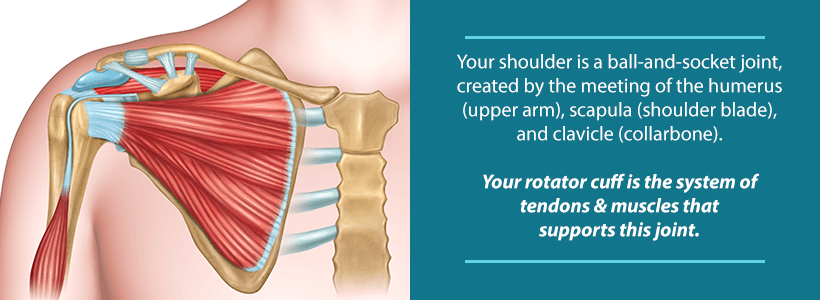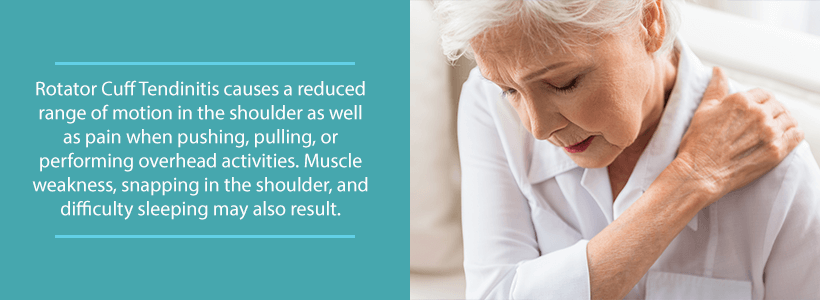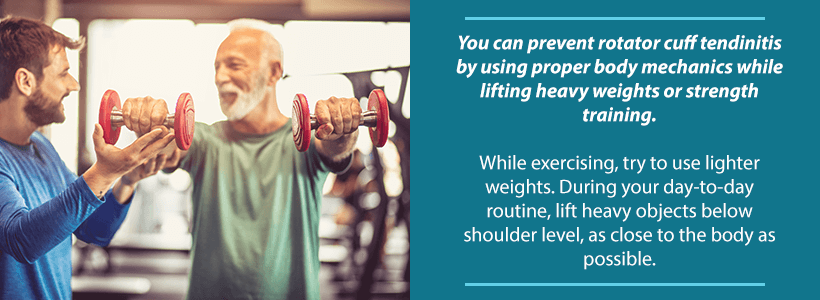What is Facet Nerve Ablation? Those who are seeking degenerative disc disease treatments have probably come across facet nerve ablation in their searches. But, is this an effective method of treating your degenerative disc disease…
Rotator Cuff Tendinitis is a leading cause of shoulder pain among athletes and middle-aged individuals. But, anyone can develop this disorder.
Our shoulders are the most flexible joints in our body. And, it’s easy to take these joints for granted until we start to feel pain. This guide will help you understand how the shoulder works and how rotator cuff tendinitis can develop.
Understanding Your Shoulder
Three main bones make up your shoulder. Your upper arm bone, known as the humerus, connects with the scapula (or shoulder blade) and the clavicle (or collarbone). These bones are connected by a series of muscles and tendons at the shoulder joint. This ball-and-socket joint is also known as the rotator cuff.
At the rotator cuff, four main tendons merge over the top of the humerus. They connect with muscles as well as the shoulder bones. This structure keeps the shoulder stabilized and prevents the humerus from popping out of the joint. In addition, lubricating sacs, called the bursae, help the rotator cuff tendons to glide during movement.
The rotator cuff controls the flexibility and movement of the shoulder. As the name suggests, it allows the shoulder and arm to rotate up and down, from front to back, and in or out.
Although your shoulder joint is reinforced by tendons, muscles, and ligaments, certain movements and activities can cause injury.
What is Rotator Cuff Tendinitis?
Sometimes referred to as shoulder impingement or impingement syndrome, this condition involves the tendons of the shoulder joint. When these tendons are damaged or irritated, it causes inflammation, which then results in pain and swelling.
Rotator cuff tendinitis usually develops gradually as a result of repeated irritation to the area. It occurs in athletes who engage in repetitive overhead movements like throwing, swimming, or playing tennis. In addition, as we get older, our muscles and tendons are more prone to injury. Those with occupations that require repetitive lifting or other overhead activities (like painting) are also at risk. In addition, a trauma to the area, like falling, can injure the shoulder tendons.
Symptoms of Rotator Cuff Tendinitis
Symptoms of this condition usually start with dull pain or swelling in the front and top of the shoulder. You may also experience pain in the outer part of the upper arm. This pain may worsen when you lift your arm or attempt to reach behind you.
Other symptoms include:
- Decreased range of motion in the arm and shoulder
- Sudden pain while reaching, lifting, or performing overhead activities
- Pain while pushing, pulling, or lying on your side
- Difficulty sleeping because of shoulder pain
- Muscle weakness
- A clicking sound in the shoulder when raising your arm
- Trouble with daily activities such as putting on a shirt or brushing your hair
Treating Rotator Cuff Tendinitis
A proper diagnosis of tendinitis is needed to rule out other causes like a bone fracture or arthritis. Your doctor can diagnose your shoulder pain by discussing symptoms and completing a physical exam.
In some cases, the doctor may order imaging tests such as x-rays or MRIs to view the damage to your shoulder joint and soft tissues.
Conservative Approaches
Most of the time, this condition only requires conservative treatments. Resting and icing the area may help with the pain and swelling. It is important not to return to stressful overhead activities until your tendons and muscles have had a chance to heal.
Pain management can also include using anti-inflammatory medications (or NSAIDs). Over-the-counter medications like aspirin or ibuprofen can help to reduce pain and swelling.
A physical therapist can perform strengthening exercises to stabilize the area and improve your range of motion. In addition, a physical therapist will suggest ways you can change your habits and prevent further irritation of the shoulder joint.
In more severe cases, a steroid injection may be used to reduce inflammation.
Surgical Options
If these conservative approaches fail to provide relief after several months, surgery may be the next option. Surgery is usually recommended when there is a tear in one of the rotator cuff tendons.
In many cases, surgery involves a shoulder arthroscopy. During this procedure, the orthopedic surgeon makes a small incision in the shoulder and inserts a tiny camera. The camera allows the surgeon to assess the affected area and shave off small parts of bone, giving the cuff tendon more space. This prevents further irritation and pinching of the tendon. This procedure also allows the surgeon to remove damaged tissue and repair minor tendon tears.
When a tendon has a major tear, open surgery may be necessary. The surgeon will create more space for the damaged tendon by trimming the tendon and cutting out a small piece of the humerus. Then the surgeon reattaches the tendon to the humerus with stitches or tacks.
Preventing Rotator Cuff Tendinitis
There are a few things you can do to decrease shoulder strain and thus reduce your risk of developing rotator cuff tendinitis. These things include:
- Use lighter weights during strength training.
- Lift heavy objects below the shoulder level.
- Lift heavy objects close to your body.
- Avoid push-ups, bench presses, and shoulder press exercises if painful.
- Maintain a good posture.
- Swim with a sidestroke or breaststroke.
Seeking Treatment for your Shoulder Pain
If resting or over-the-counter medications aren’t relieving your shoulder pain, consulting with a doctor is the next logical step. Our shoulder experts at Orthopedic & Laser Spine Surgery want to help you pinpoint the source of your pain and provide you with the most appropriate treatment.
Our dedicated team offers a comprehensive program using only the latest technology and treatments. If surgery is an option for you, then we specialize in minimally invasive techniques that will make your recovery period shorter. Schedule a consultation now to receive an accurate diagnosis or a valued second opinion!




